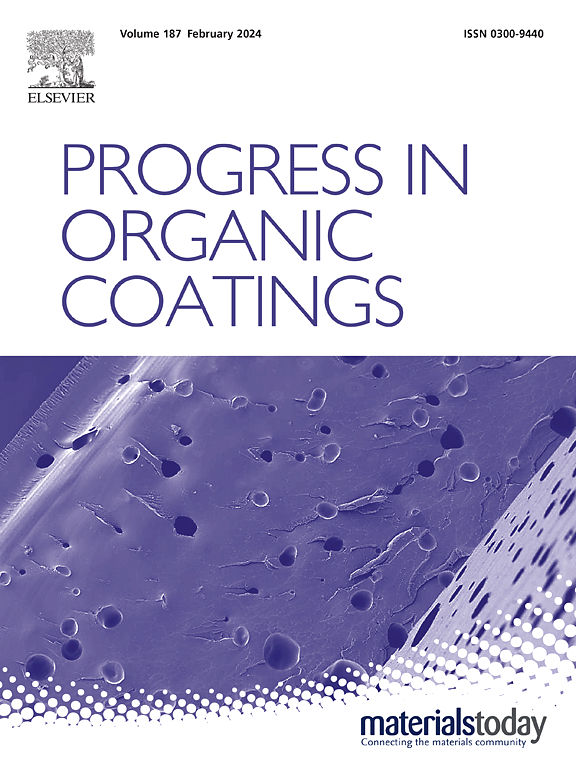水性交联聚氨酯乳胶膜由丙烯酸和聚异氰酸酯颗粒组成
IF 6.5
2区 材料科学
Q1 CHEMISTRY, APPLIED
引用次数: 0
摘要
水性乳胶薄膜是涂料、印刷和胶粘剂行业的重要材料。在乳胶膜中引入交联结构以改善其力学性能的研究一直在进行。在本研究中,我们以含羟基丙烯酸乳液颗粒(AL颗粒)的水性分散体为基础成膜材料,以聚异氰酸酯纳米颗粒(BPI纳米颗粒)为交联剂制备乳胶膜。电泳光散射、透射电镜和衰减全反射-红外研究表明,AL颗粒和BPI纳米颗粒在水介质中不相互作用,独立存在,通过25℃干燥去除分散液中的水分,使颗粒相互接触,形成共混膜。此外,在高于AL颗粒和BPI纳米颗粒玻璃化转变温度的90℃下加热共混膜,会导致AL和BPI组分的相互扩散。交联的形成是通过在140℃加热AL中的羟基与BPI中释放的阻断剂生成的异氰酸酯基团之间形成聚氨酯键来实现的。拉伸试验、划痕硬度试验和表面硬度测量证实,聚氨酯基交联提高了薄膜的力学性能。本文章由计算机程序翻译,如有差异,请以英文原文为准。

Waterborne crosslinked polyurethane latex film formed from acrylic and blocked polyisocyanate particles
Waterborne latex films are an essential material in coating, print, and adhesive industries. There have been continuous researches on introduction of cross-linked structures to the latex films to improve their mechanical properties. In this study, we develop latex film fabricated from aqueous dispersion of hydroxy group-containing acrylic latex particles (AL particles) as a base film-forming material and blocked polyisocyanate nanoparticles (BPI nanoparticles) as a crosslinker. Electrophoretic light scattering, transmission electron microscopy and attenuated total reflection-infrared studies indicate that AL particles and BPI nanoparticles do not interact with each other and exist independently in aqueous media, and that removal of water from the dispersion via drying at 25 °C causes the particles to contact each other, generating a blend film. Furthermore, heating of the blend film at 90 °C, above the glass transition temperatures of the AL particles and BPI nanoparticles, leads to interdiffusion of the AL and BPI components. Formation of crosslinking is realized by heating at 140 °C via urethane bond formation between hydroxy groups in AL and isocyanate groups generated from BPI by release of blocking agents. Tensile tests, scratch hardness tests and surface hardness measurements confirm that mechanical property of the films is improved via urethane-based crosslinking.
求助全文
通过发布文献求助,成功后即可免费获取论文全文。
去求助
来源期刊

Progress in Organic Coatings
工程技术-材料科学:膜
CiteScore
11.40
自引率
15.20%
发文量
577
审稿时长
48 days
期刊介绍:
The aim of this international journal is to analyse and publicise the progress and current state of knowledge in the field of organic coatings and related materials. The Editors and the Editorial Board members will solicit both review and research papers from academic and industrial scientists who are actively engaged in research and development or, in the case of review papers, have extensive experience in the subject to be reviewed. Unsolicited manuscripts will be accepted if they meet the journal''s requirements. The journal publishes papers dealing with such subjects as:
• Chemical, physical and technological properties of organic coatings and related materials
• Problems and methods of preparation, manufacture and application of these materials
• Performance, testing and analysis.
 求助内容:
求助内容: 应助结果提醒方式:
应助结果提醒方式:


